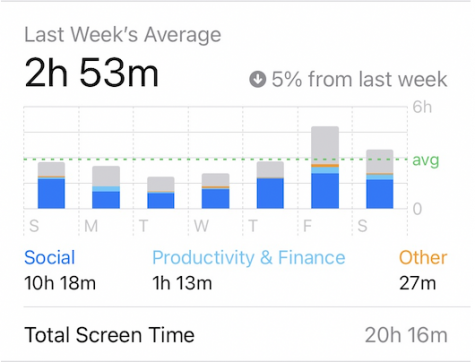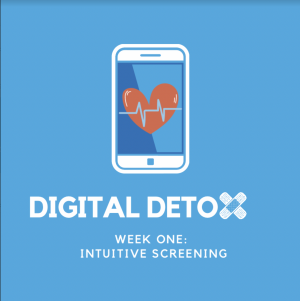Charlotte: Digital Detox
December 10, 2021
 Seven hours a day. 49 hours a week. 210 hours a month. 2520 hours a year. Put most shockingly perhaps, 105 days a year.
Seven hours a day. 49 hours a week. 210 hours a month. 2520 hours a year. Put most shockingly perhaps, 105 days a year.
According to a report from Common Sense Media, teenagers spend an average of seven hours and 22 minutes on their phones each day, excluding time spent on schoolwork.
When I first saw this figure, I was disgusted, for lack of a better term. Now more than ever, with college applications looming, I feel like I never have enough time. So learning that I might spend almost a third of my day mindlessly scrolling through my phone was startling, to say the least.
Eventually, I mustered up the courage to check my own screen time report. I was still mildly disgusted, but slightly relieved, to see two hours and 53 minutes stare back at me.
Enlightened by this knowledge, I began seeking out ways to regain control of those lost minutes and after exchanging stories with Nora, the digital detox began. Following Nora’s lead, I also attempted to apply James’ three steps for “conscious connectivity.”
Week One: Intuitive Screening
Step One: Reflecting on Responsibilities
This stage involved reflecting upon why we as users feel the need to continuously check our phones.
I realized that for me, my nasty habit of compulsively checking my phone every five minutes was rooted in a fear of missing important messages, or being uninformed about the world around me.
Though I initially check my phone for messaging and news/information purposes to lull those fears, I often find myself becoming sidetracked, which eventually ends in mindless scrolling and creates a vicious cycle of lost time.
After recognizing this, I determined that in my digital detox, I would primarily target my social media usage. This would leave my primary uses for my phone, messaging and news/information, available while eliminating or, at the very least, reducing the distractions.
Step Two: Thinking through Dilemmas
Now that I had a focus, I needed to break it down.
As displayed in my screen time report, the majority of my screen time hours for the week consisted of social media platforms Snapchat and Instagram. The rest of my screen time was attributed with more random, non-social media apps that included everything from an hour spent on healthline.com to, don’t ask me how, almost 25 minutes on Apple’s clock app.
Regardless, Instagram and Snapchat still contributed the most minutes to my screen time by far, making them my primary targets.
Step Three: Envisioning Action Steps
With the targets in place, my next step was to create an action plan that would strategically reduce the attraction of each of my common distractions or, in the likely event that this method failed, restrict their accessibility.
In week two, I will be setting screen time limits on Snapchat and Instagram with a maximum of 45 minutes on Snapchat and 15 minutes on Instagram.
With battle plans laid out, I’m prepared to face and resist any distraction that might come my way in week two… at least I hope. Same time next week?
Week Two
I’ll admit that I have actually already had limits on my screen time for a few months before this. They were less restrictive than the ones I set in place this week, but they had definitely already cut back my screen time significantly from what it was about a year ago. Still, I wanted to cut that number down even more, as even wasting two to three hours each day on my phone seems like way too much.
The biggest change I saw this week was in my mindset while using social media.
Because my week one screen time was already a reduction from what it once was, I wasn’t expecting massive change this week since I only lowered the limits slightly. The change that I did see this week though was in how that time was spent.
For the first few days, I found myself trying to strategize how my time was spent, using my social media apps for shorter amounts of time but almost more often than before. It wasn’t until Wednesday that I decided to fully embrace the challenge and lean out of the urge to constantly check my social media apps and become more present in my real life.
For me, becoming more present in my real life meant instead of checking in with friends on social media, I spent more time with them in person or took the time to call them and have live conversations. Although these live conversations increased my screen time and I was still technically on my phone, the time felt much more constructive and meaningful than the quick text exchanges that they replaced.
Not only were my conversations more productive this week, but I also found myself being more productive overall as well. By spending less time mindlessly clicking and scrolling, I was able to redirect my focus and effort into my school work.
I was much more on top of my assignments this week, which freed up time in other areas of my life too. Essentially, there was an almost domino effect on time in my life.
This week, my screen time decreased to two hours 32 minutes from my initial two hours 50 minutes. It was a notable decrease, but after seeing the positive impact that setting just a few limits made in my life, I want to take this goal towards “conscious connectivity” a step farther.
Week Three
After reflecting on week two, I decided that maybe how much time I was spending on my phone wasn’t actually as important as how that time was spent. With that in mind, I decided to delete social media apps off of my phone.
We’ve all heard the saying “you never know what you’ve got until it’s gone.” It sounds dramatic, but this week it was true.
After deleting all of my social media apps, I found myself forgetting I had done it and frequently caught myself almost clicking the blank spaces where my apps used to be. It wasn’t so much that I missed my social media as that only then did I realize how bad of a habit checking it had become.
Most of the time when I found myself reaching for my social media apps, I wasn’t even all that interested in what they contained, but it was almost as though I was conditioned to compulsively check in.
Without social media, I felt a little disconnected at first. I wasn’t actually missing any news or meaningful information from social media, but the idea that I might be was what I felt most dramatically.
In realizing this, I came to understand why social media has the power it does. During this week, I had conversations with a few people who noticed my absence. In each one, the person I was talking to expressed admiration for what I was doing, noting that they wished they could do the same.
But the thing is, every single one of them could. They were all faced with the same decision I was at the start of each day this week. The only difference was that they made the conscious decision to engage with the social media that I was choosing to disconnect from. But maybe it wasn’t such a conscious decision for them.
When I made this point, I was always met with either an “Oh yeah, I guess you’re right” or “Oh, but I could never.”
For the first type of response, there was always a pause before it. It was almost as though they had never considered that engaging with social media is a choice not a requirement.
For the latter response, none paused before speaking. Their responses were almost immediate, as if my suggesting it to begin with was illogical. I was taken aback by those responses, as it revealed the scope of just how dependent we have become on social media.
No matter the response, every person I talked to led me to the same conclusion. Social media has become the dominant force that it has not because of any particularly alluring content but rather because it offers connection.
Never once this week did I find myself missing the actual content of my social media but instead found myself feeling disconnected to my peers around me. Social media’s addictive nature stems from a human desire to feel as though we are a part of something, and when that connection is broken, we feel withdrawal symptoms from the social network that we now, unfortunately, rely on to connect us with each other.
Ultimately, though I started this “detox” hoping to reduce my screen time overall, I came to learn that how I was spending this screen time was actually a larger threat than the quantity of time. After becoming aware of my own dependence on social media through this detox, I will likely never look at social media the same way again nor return to using it like I did before.
Even if you would never consider doing Nora and I’s digital detox on your own, I hope that you will be more conscious of your own social media usage and, if you find that you have one, overcome the addiction.






